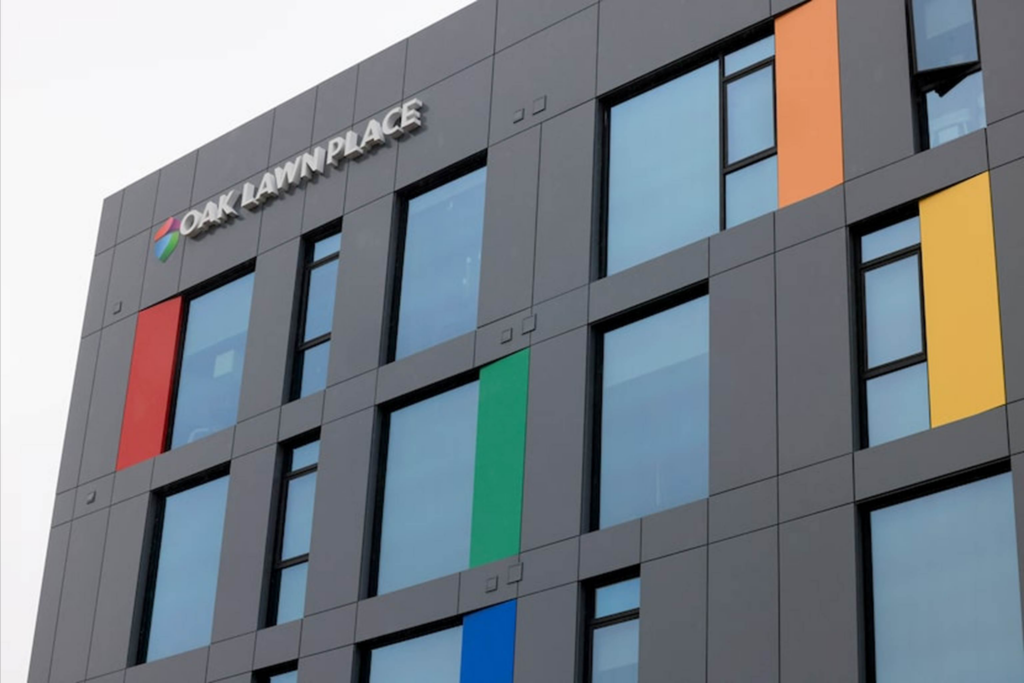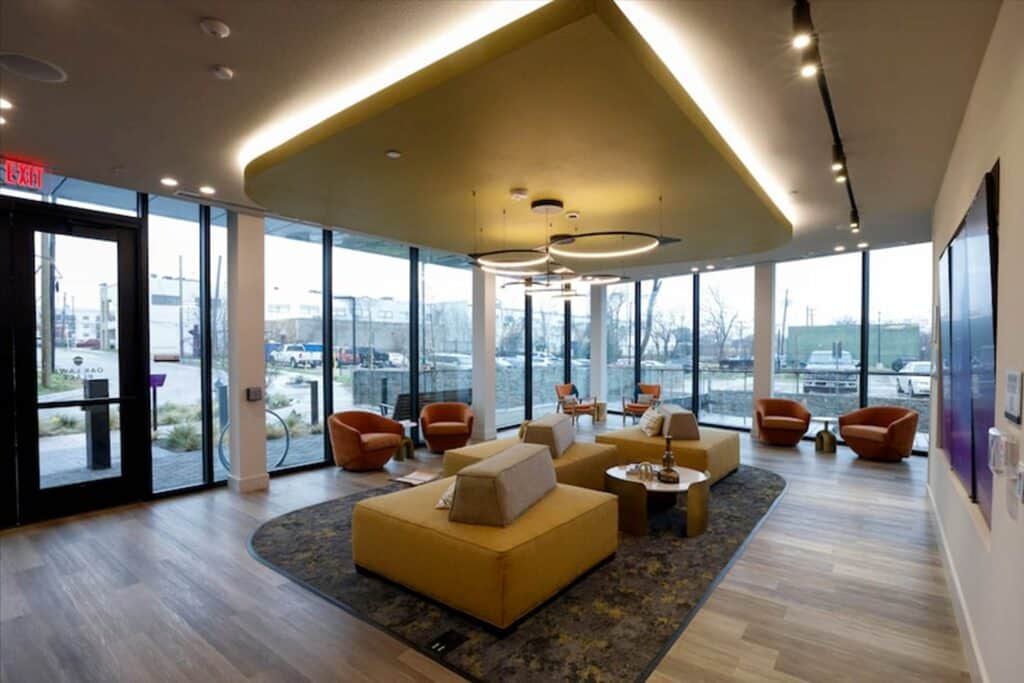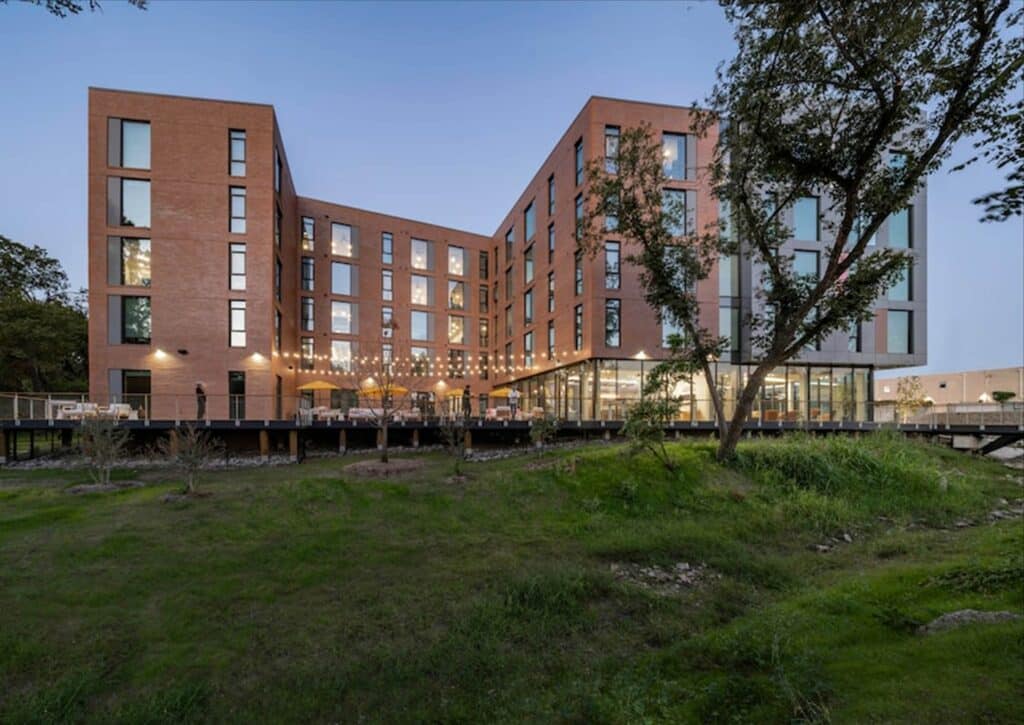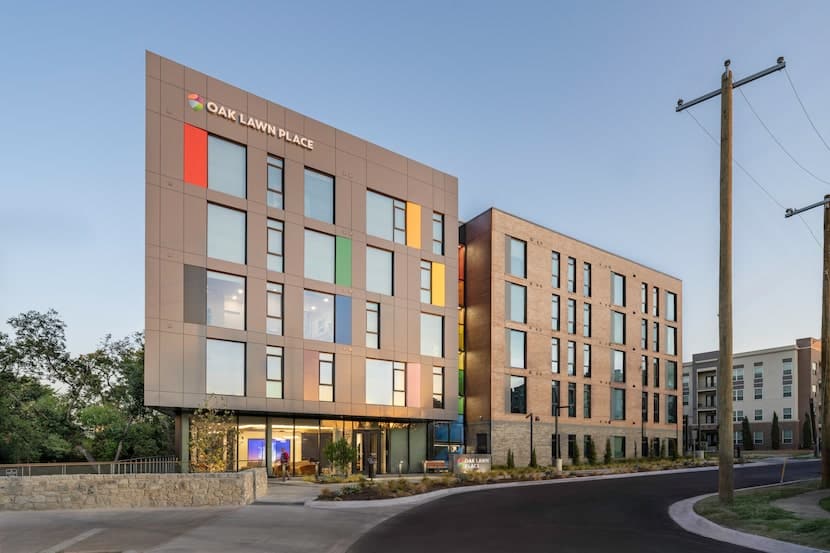New apartments bring dignity to LGBTQ seniors on a once-blighted site.
By Mark Lamster
Architecture Critic
Feb. 12, 2025
|
Updated 6:00 a.m. CST
|
5 min. read

Oak Lawn Place, affordable housing aimed at LGBTQ seniors. (James Steinkamp / Perkins & Will)
You can find my favorite new building in Dallas on what was until recently a junkyard littered with rusting boats, abandoned cars, discarded beer cans and 48 feral cats. This unpromising location, along the flight path into Love Field and a block from an elevated DART track, is now home to Oak Lawn Place, an affordable housing project aimed at (but not exclusive to) LGBTQ seniors.
If you happened to drive by — unlikely, given its semi-secluded location on a street that’s all of two blocks — you might not notice it, or give it more than a passing thought. In its scale and boxy shape, it’s not too different from the generic, four- to five-story apartment blocks that make up so much of the Dallas landscape.
But Oak Lawn Place is different: It is sited more thoughtfully, more sophisticated in its design, built with more durable and attractive materials, and more generous in its planning, both inside and out. It would be impressive for a building renting at luxury rates; for an affordable housing project, it is frankly remarkable, and a far cry from the decrepit, dank, dark and dangerous buildings typically associated with the form.

Oak Lawn Place facade.(Elias Valverde II / Staff Photographer)
“Everybody has ideas about what affordable housing means, and this project busts people’s perceptions.” says Cece Cox, the chief executive of Resource Center, the nonprofit founded during the AIDS crisis in 1983 to support the LGBTQ community in and around Dallas. Oak Lawn Place is its first entry into the housing market, completed in partnership with Matthews Southwest and Volunteers of America. As its name suggests, the building is in Oak Lawn, the neighborhood that has been the epicenter of gay life in Dallas for decades.
Visitors to the five-story, $31 million project arrive at a square bay faced by aluminum panels with colored accents — red, white, yellow, orange, blue, pink — that hint at but don’t directly reproduce the pride flag. “We didn’t want to be cliche, and we didn’t want to out the people who live here,” says Cox. “Safety is still a concern for queer people.”
Within is a bright, open lobby fronted by glass on all sides. “It’s a welcoming gesture,” says Ron Stelmarski, who led design of the project for the Dallas office of Perkins & Will. “You have sight lines all the way through, so you are able to see everything all at once.” That includes a dining area, a conference room, a gym and a generously scaled patio deck that sits in the open space between the wings of the building, which takes the form of a backward, squared-off C. From the deck, which winds around the building, there are views of a tree-lined creek. (On a recent visit, a hawk perched on one of those trees, apparently enjoying the view of the building.)
The bulk of the building is faced in brick — black at the lowest level, a reference to the blackland prairie that once made up the Dallas landscape — and a warmer beige above to give the building a sense of lightness. The use of brick also imparts an impression ofsolidity and permanence, and distinguishes it from so many unattractive apartment blocks faced with stucco or EIFS (pronounced ee-fis, a cheap cladding system). A well-proportioned grid of punched windows provides a sense of dignified restraint.

The lobby of Oak Lawn Place.(Elias Valverde II / Staff Photographer)
Oak Lawn Place has 84 units, the vast majority (79) being one-bedrooms. The floor plans are virtually identical, efficiently designed with a kitchen and living area on one side, and bedroom, bath, and a closet with a washer/dryer on the other. Five of the units are designed specifically for those with hearing and vision disabilities, using light and sound cues for certain notifications.
The entire building is aimed at accommodating the impairments that come with aging, with distances from service spaces kept short, wide hallways, quieting acoustics, and colors and patterns chosen for maximum readability. Furniture was selected with an eye to the demands of seniors, with heights and arm rests that make it easy to sit down and get up. Signage is boldly designed and positioned. “We paid a lot of attention to wayfinding in general to make it very clear and easy to read,” says Stelmarski.
There is a dire need for supportive housing for American seniors — according to the National Council on Aging, roughly 80% of households with older adults are struggling financially — but the need is especially acute for those in the LGBTQ community. LGBTQ seniors tend to have fewer dependents on whom they can rely for support, and only recently became eligible for the benefits of legal marriage. “Because our relationships weren’t recognized legally until 2015, we often have a much lower household income than our heterosexual counterparts,” says Cox.
To qualify for housing at Oak Lawn Place, residents’ annual income must fall between 30 and 60 percent of the Dallas area median income (AMI). Rents for a one-bedroom unit range from $567 to $1,118, depending on the resident.
Oak Lawn Place provides something more than decent shelter at a reasonable price. “It’s more like a community than just an apartment building,” says Michael Saldivar, who has lived at Oak Lawn Place with his two dogs since its opening last summer. “Everybody here, we’re like one giant family. It’s a very unique, one-of-a-kind place.” Such connection is especially important for LGBTQ seniors, the majority of whom live alone and report a sense of isolation, according to the advocacy group SAGE.

View of Oak Lawn Place showing its rear patio.(James Steinkamp / Perkins & Will)
The sense of community is reinforced by an art program that runs throughout the building. Each floor has a digital work by local artists Anderson + Kincaid that portrays a resident of Oak Lawn superimposed over a vivid backdrop. Hallways are enlivened by floral murals by Karen Chen.
“The best housing endures because it brings people together as much as giving them their own sense of privacy,” says Stelmarski, who was also the designer of the Galbraith, the sharply planned and detailed mixed-income housing block completed in 2022 on the edge of downtown.
Dallas needs more housing like Oak Lawn Place (and the Galbraith), especially at a time of increasing hostility and intolerance toward minority groups, the LGBTQ community in particular. “We built this housing development during COVID and during the last Texas legislative session with all the things that were targeted at our community,” says Cox. “It’s miraculous in some ways that we continue to do what we’re doing, but that’s just the heart and soul of Resource Center.”
It should not require miracles to build quality affordable housing, a basic human right. Dallas has considerable work to do on this front, but in Oak Lawn Place it has a model of how to give comfort and respect to those who have so often had their needs denied.







